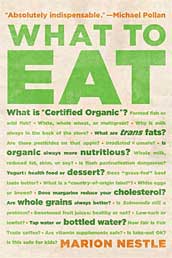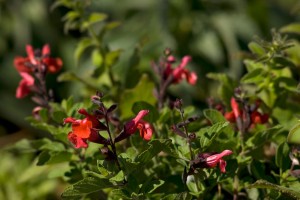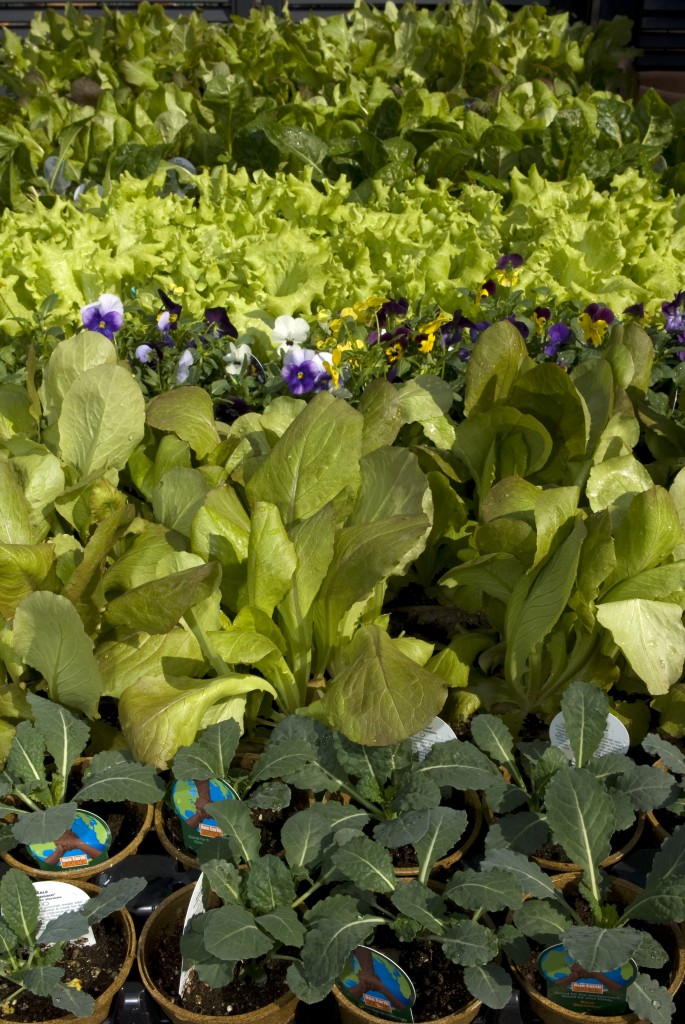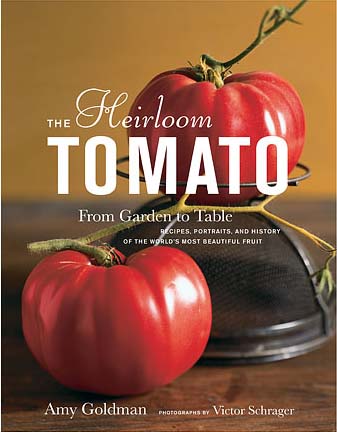Inside The New York Botanical Garden
NYBGShop in the Garden
Posted in Exhibitions, Shop/Book Reviews, The Edible Garden on June 24 2009, by Plant Talk
 John Suskewich is Book Manager for Shop in the Garden.
John Suskewich is Book Manager for Shop in the Garden.
With apologies to Cicero but with respect to American eating habits: O tempura! O morels!
The Western diet—based on fats, processed foods and convenience foods, and industrialized agriculture—may be responsible for a host of ills. In the last hundred years or so, it “has changed in ways that are making us increasingly sick and fat,” one food journalist recently commented. Ever more frequently and from many quarters, it is being questioned, rethought, reinvented. So it is that The Edible Garden, the Botanical Garden’s summer-long celebration of growing, preparing, and eating great food, comes at a propitious moment. With the current debate and state of eating in the United States, what do our on-site exhibitions bring to the table? Here are a few sources for perspective on this issue.
 Journalist/gardener Michael Pollan is one of the pioneers in sounding the alarm about the American diet. His most recent book, In Defense of Food, argues thoroughly, convincingly, and very readably that good health will come when we reject the current reliance on fast food, food substitutes, food byproducts, engineered food, overpackaged food, overprocessed food, or any comestible with an adjective attached. His manifesto is very close to the mission of this institution—to be an advocate for the plant kingdom—and it boils down to: “Eat food. Not too much. Mostly plants.”
Journalist/gardener Michael Pollan is one of the pioneers in sounding the alarm about the American diet. His most recent book, In Defense of Food, argues thoroughly, convincingly, and very readably that good health will come when we reject the current reliance on fast food, food substitutes, food byproducts, engineered food, overpackaged food, overprocessed food, or any comestible with an adjective attached. His manifesto is very close to the mission of this institution—to be an advocate for the plant kingdom—and it boils down to: “Eat food. Not too much. Mostly plants.”
 What to Eat by Marion Nestle takes this advice and turns it into a field guide for the supermarket. What is fresh, organic, low fat, reduced fat, no fat, trans fat, polyunsaturated fat, fat free?? For the consumer trying to “do the right thing,” the grocery chain is ground zero in the food chain, but it is a mine field, with marketing, packaging, and processing tripwires that can land you with eggbeaters all over your face. What to Eat analyzes the claims, counterclaims, labels, small print, jargon, subtext, and easy-open cartons to uncover the real truth about the dairy case and the frozen food aisle to make shoppers more savvy.
What to Eat by Marion Nestle takes this advice and turns it into a field guide for the supermarket. What is fresh, organic, low fat, reduced fat, no fat, trans fat, polyunsaturated fat, fat free?? For the consumer trying to “do the right thing,” the grocery chain is ground zero in the food chain, but it is a mine field, with marketing, packaging, and processing tripwires that can land you with eggbeaters all over your face. What to Eat analyzes the claims, counterclaims, labels, small print, jargon, subtext, and easy-open cartons to uncover the real truth about the dairy case and the frozen food aisle to make shoppers more savvy.
Read More
Posted in Gardening Tips, Shop/Book Reviews on June 4 2009, by Plant Talk
 |
Richard Pickett is Director of Retail Operations. |
 Salvia has been seducing gardeners for centuries. Roman scientist and historian Pliny the Elder was the first to use the Latin name Salvia. The name derives from salvare, to heal and save, and salvus, meaning uninjured or whole. But for today’s avid gardeners salvias, or sages as they are commonly known, are not only used for their culinary and medicinal properties but for their vibrant flowers and easy cultivation in almost any climate.
Salvia has been seducing gardeners for centuries. Roman scientist and historian Pliny the Elder was the first to use the Latin name Salvia. The name derives from salvare, to heal and save, and salvus, meaning uninjured or whole. But for today’s avid gardeners salvias, or sages as they are commonly known, are not only used for their culinary and medicinal properties but for their vibrant flowers and easy cultivation in almost any climate.
At the Botanical Garden, you can see several species of Salvia by visiting the Perennial Garden, the Rock Garden, and the Home Gardening Center. The Family Garden has planted a number of varieties as well, including one with dark violet flowers, Salvia ‘Indigo Spires’, and bog sage, Salvia ‘Ulginosa’. And, of course, Martha Stewart used plenty of Salvia in her recent redesign of the historic Herb Garden. You can even download a site plan of Martha Stewart’s Culinary Herb Garden, which will be a feature of The Edible Garden celebration this summer.
 If you’re inspired to include salvias in your own garden, be it urban or suburban, you’ll find a wide variety of both perennial and annual salvias in Shop in the Garden, from Salvia officinalis, culinary sage, to Salvia nemorosa, perennial meadow sage, and the unusual annual, black-flowered Salvia discolor.
If you’re inspired to include salvias in your own garden, be it urban or suburban, you’ll find a wide variety of both perennial and annual salvias in Shop in the Garden, from Salvia officinalis, culinary sage, to Salvia nemorosa, perennial meadow sage, and the unusual annual, black-flowered Salvia discolor.
The genus Salvia has arguably the truest blues and brightest reds of any group of plants and their applications are endless—borders, baskets, herb gardens, and patio pots to name a few. There is room in any garden, terrace, or patio for a Salvia or two. They are deer-resistant, relatively drought tolerant, and attractive to hummingbirds and butterflies. What more could a gardener ask?
Posted in Shop/Book Reviews on May 7 2009, by Plant Talk

Throughout the planting and growing season you’ll find many varieties of USDA-certified organic edible greens, herbs, and vegetables available at Shop in the Garden, where you can also pick up tools, gloves, rain barrels, and more. Each purchase you make helps to support the many programs of The New York Botanical Garden.
Posted in Shop/Book Reviews on February 25 2009, by Plant Talk
The Year’s “Must-Reads”
 John Suskewich is Book Manager for Shop in the Garden.
John Suskewich is Book Manager for Shop in the Garden.
To somebody who’s really into plants, February finds the cosmic garden center always filled with five-pints of that herbaceous perennial called hope, so I’m thinking ahead. I’m looking forward to that lengthening daylight. I’m thinking about those first snowdrops, about mud and muck, about witch-hazels and Rijnveld’s Early Sensation and seed orders and Lenten hellebores and unpaid credit card balances because of plant purchases, and then there are books.
Here are several new books that will tell me what I’m doing wrong and what plants that I don’t have that I gotta have, books about other gardens and other gardeners, books that are celebratory and books that are valedictory, books that are encouraging and books that are alarming. Some of these are out now and some will be published later in the year, but here is a selection, 9 for ’09, of books about plants and the people who are mesmerized by them.
The Edible Schoolyard by Alice Waters
At the acclaimed restaurant Chez Panisse, founder and chef Alice Waters created a style of cooking that is seasonal, market based, plant centered, and not just nutritional but nurturing. The Edible Schoolyard takes this template and applies it to education to reinvent the way we teach our kids. Her goals are our goals here at The New York Botanical Garden: to inject nature into our lives in a transformational way.
William Robinson, The Wild Gardener by Richard Bisgrove
William Robinson is one of those transcendent figures that everyone has heard of but whose achievement has been so long unstudied that newbies like me aren’t quite sure what he accomplished. One of the finest garden historians, Richard Bisgrove, reexamines the life and achievement of this icon who popularized the wild garden and the cottage garden and in whose works one finds the first intimations of a holistic view of gardening.
Listening to Stone by Dan Snow
What an inspired use of feldspar! If you need a dry stone wall with poetry as the mortar, Dan Snow is your mason. Listening to Stone is a look at his profession and an appreciation of his medium as well as a study of some of his recent constructions, which turn something weighty and substantial into works of art that are arrestingly enigmatic.
The New Terrarium by Tovah Martin
I was in college during the ’70s, the heyday of macramé plant holders, the original cast recording of Pippin, beanbag furniture, and terrariums. (A terrarium was something you made when you got tired of netting dead neon tetras out of your 20-gallon fish tank.) Tovah Martin, one of our best garden writers, rethinks the concept with new containers and new plantings and reminds us that it is still one of the best methods for bringing and keeping nature indoors.
Read about John’s other selected books after the jump.
Read More
Posted in Shop/Book Reviews on September 24 2008, by Plant Talk
 John Suskewich is Book Manager for Shop in the Garden.
John Suskewich is Book Manager for Shop in the Garden.
 NYBG’s Farmers Market, which rolls in here every Wednesday through summer and fall, is a feast and a fanfare of fresh fruits and veggies. As beautiful as jewelry but full of thiamin and riboflavin, the produce glistens when the tents are first unfurled, and this year the tomatoes—Black Cherry, Sungold, Brandywine, Bicolor—seemed to glimmer like a Tiffany’s window of semiprecious stones.
NYBG’s Farmers Market, which rolls in here every Wednesday through summer and fall, is a feast and a fanfare of fresh fruits and veggies. As beautiful as jewelry but full of thiamin and riboflavin, the produce glistens when the tents are first unfurled, and this year the tomatoes—Black Cherry, Sungold, Brandywine, Bicolor—seemed to glimmer like a Tiffany’s window of semiprecious stones.
Ah the tomato! This, the cynosure of the Solanaceae, is sweetly celebrated in an excellent new publication, The Heirloom Tomato, by our board member and chair of Seed Savers Exchange, Amy Goldman. The book is all about selecting, growing, and eating tomatoes, but the heart of the volume is a 150-page gallery of the fruit, a museum of Lycopersicon, with photographs by Victor Schrager, who turns even homely “Radiator Charlie’s Mortgage Lifter” into a Vermeer. The descriptions by Dr. Goldman include specs for each variety on size, weight, shape, color, and texture, and her interpretative material includes archival research and nuggets of oral history that illuminate our lost rural history as evocatively as a tintype.
The Heirloom Tomato is a book for anyone who loves gardening, plants, food, tomatoes, art and/or language. It is the third volume in the Goldman/Schrager collaboration. They created a template with two works on cucurbits: Melons for the Passionate Grower and The Compleat Squash, and they have now brought it to such a state of perfection I wouldn’t be surprised if they next turned their attention to okra, or maybe kohlrabi.
A selection of images from the book is on display in the Botanical Garden’s Arthur and Janet Ross Gallery in The Heirloom Tomato: An Exhibition of Photographs by Victor Schrager—Portraits of Historic Tomato Varieties from the Gardens of Amy Goldman.
 John Suskewich is Book Manager for Shop in the Garden.
John Suskewich is Book Manager for Shop in the Garden. Journalist/gardener Michael Pollan is one of the pioneers in sounding the alarm about the American diet. His most recent book, In Defense of Food, argues thoroughly, convincingly, and very readably that good health will come when we reject the current reliance on fast food, food substitutes, food byproducts, engineered food, overpackaged food, overprocessed food, or any comestible with an adjective attached. His manifesto is very close to the mission of this institution—to be an advocate for the plant kingdom—and it boils down to: “Eat food. Not too much. Mostly plants.”
Journalist/gardener Michael Pollan is one of the pioneers in sounding the alarm about the American diet. His most recent book, In Defense of Food, argues thoroughly, convincingly, and very readably that good health will come when we reject the current reliance on fast food, food substitutes, food byproducts, engineered food, overpackaged food, overprocessed food, or any comestible with an adjective attached. His manifesto is very close to the mission of this institution—to be an advocate for the plant kingdom—and it boils down to: “Eat food. Not too much. Mostly plants.” What to Eat by Marion Nestle takes this advice and turns it into a field guide for the supermarket. What is fresh, organic, low fat, reduced fat, no fat, trans fat, polyunsaturated fat, fat free?? For the consumer trying to “do the right thing,” the grocery chain is ground zero in the food chain, but it is a mine field, with marketing, packaging, and processing tripwires that can land you with eggbeaters all over your face. What to Eat analyzes the claims, counterclaims, labels, small print, jargon, subtext, and easy-open cartons to uncover the real truth about the dairy case and the frozen food aisle to make shoppers more savvy.
What to Eat by Marion Nestle takes this advice and turns it into a field guide for the supermarket. What is fresh, organic, low fat, reduced fat, no fat, trans fat, polyunsaturated fat, fat free?? For the consumer trying to “do the right thing,” the grocery chain is ground zero in the food chain, but it is a mine field, with marketing, packaging, and processing tripwires that can land you with eggbeaters all over your face. What to Eat analyzes the claims, counterclaims, labels, small print, jargon, subtext, and easy-open cartons to uncover the real truth about the dairy case and the frozen food aisle to make shoppers more savvy. 




